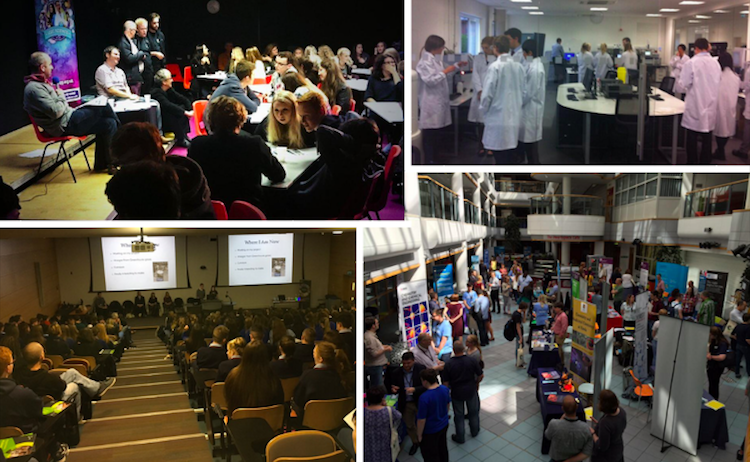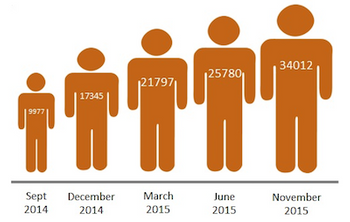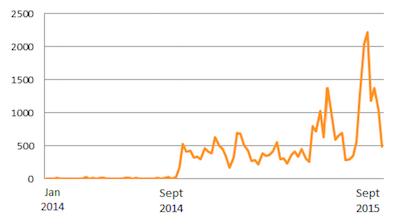ChemNet - an online & physical community for 14-18 year olds
Success Achieved
How the Royal Society of Chemistry created a community for potential professionals in chemistry, recruited 25,000 members and held 70 Events all in a year.
Organisation
| Name: | Royal Society of Chemistry |
| Member geography: | National |
| Members: | National |
| Based in: | United Kingdom |
| Website: | http://www.rsc.org |
Introduction
ChemNet has an audience made of “digital natives”. In a world of instant, on-the-go information, of global social media, and of clean and effective online user journeys, any organisation working with this age group needs to meet the high benchmark expected.
Alongside our engaging events, we knew that to reach out to this audience, 14 - 18 year olds, we had to provide them with a community they could call their own. An environment that gives our educational and career guidance the greatest effect when combined with their sense of belonging and peer support.
Discovery
Prior to September 2014, ChemNet has existed in our core membership community, MyRSC. The members of this community are a mix of academics, industrialists, teachers, and students. Providing school students with a small part of this site and expecting to be able to influence, engage and excite them about the chemical sciences was unlikely to be successful. The user journey in particular caused confusion and ultimately a lack of participation with the website.
In addition to this, the content that was presented on this website was infrequent, and often very impromptu. This was great in terms of being able to react to trends in the science community or more generally on social media, but it did not ensure high quality content or make it easy to commit resource to the project.
There was a need to create its own site to help support the ChemNet strategic objectives. It was at this point that ChemNet gained its own identity and the processes that we have since been through have enabled us to build and now retain our relevancy with this age group.
Objectives
ChemNet is an online and physical community for 14-18 year olds studying chemistry. Created in September 2014, the website provides a safe and dynamic learning tool, incorporating a variety of educational resources, careers support, expert query services and the opportunity to access local events. ChemNet’s core objectives are:
- Engaging students with chemistry and demonstrating its relevance to everyday life.
- Influencing 14-18 year olds to take up science beyond compulsory science education.
- Providing careers and chemistry support for personal development and studies.
- Providing a peer support network to instill the benefits of teamwork and collaboration.
- Introducing professional bodies and opening doors to involvement with the Royal Society of Chemistry.
Alongside these, the Royal Society of Chemistry’s membership strategy focusses on competence, contribution, community and campaigns and ChemNet also frames these themes for this younger audience. The advice and resources made available increase competencies in a laboratory environment and train our members to think analytically.
The website encourages contribution from each and every member. Badges are awarded to members that contribute on a regular basis whether in blogs, competitions, discussions or reviews. Opportunities to meet online and at our events provide members with a community and network that will grow with them throughout their careers.
To gauge our successes against these objectives, our primary measurements are:
- Total number of ChemNet members.
- Total engagement of ChemNet website.
- Total number of members who have achieved badges.
- Total number of pageviews.
- Number of attendees and physical and online events.
Project period
September 2014 - September 2015
Project Team
- Gareth Davies, Membership Development Specialist
- Francine Atkinson, Education Executive
- Royal Society of Chemistry’s Membership, Education, Marketing, Production Services and Technology departments
Project Partners
ChemNet is built on a platform delivered on Small World Labs Community by Personify, an online community software developer based in Austin, Texas.
Activities
Our Approach
In preparation for the launch of the new website in September 2014, we had identified exactly what was required for our members to have a useful and enjoyable time on the website. This was achieved through a series of customer proposition sessions, surveys and focus groups. We then were able to develop an overarching statement for what we hoped we could deliver.
“ChemNet must supply information that is accessible, consumable and interactive. The information must be understandable, easily discoverable and of a trusted quality.”
We knew that the aggregation of marginal gains in each of these areas, would compound to considerable overall improvements, and whilst there are other areas that could also have focussed attention, these were addressed for the reasons highlighted below:
Accessible - to ensure we are reaching the widest audience, and in many cases the individuals that need the support the most we must ensure that we are accessible. We must be considerate of the diversity of our members and enable every person to gain the most out of the community.
Consumable - to ensure the information that we provide is most effective, we need to ensure it can be taken in by the reader. This can be enhaced by images, video or even simple editing. All of these small improvements can help make it consumable.
Interactive - to improve understanding and learning, our website needs to provide members with the opportunity to ask questions and engage with the information they are being presented. This can help them consolidate not only what they learn from ChemNet but from the classroom too.
Understandable - the next point is crucial to the ongoing success of our community. As we work with 14-18 year olds, the different levels of understanding is vast between the youngest and eldest members. Providing content and tools to support all members regardless of their age has been
a significant challenge, but one that we have needed to overcome to ensure that the site remains challenging and useful to all.
Discoverable - our audience is made up of people expecting to find what they need instantly. To search the internet and within a few clicks have precisely the information they are looking for. This is the same level of service that we need to provide with ChemNet, making site wide information discoverable.
Trusted – there are many sites across the web that would offer the kinds fo information our members are looking for. The unique guarantee that ChemNet can offer however is that we can ensure that the information we provide is of the quality they require.
Key Developments
Many of these areas were addressed in the two key changes that were brought in with the new website.
Firstly, the development of the site architecture and design allowed us to create an environment that minimised the difficulties that had previously been encountered by users. Improving the way that they navigate around the site, find content, and generally interact with the website has created an effective website.
Secondly, changing the process of how we plan and deliver our content has improved the regularity and quality.
Moving from our sporadic creation of content we developed a two pronged approach. Implementing a 12-6-1 month plan which was structured around a rolling timeline:
- 12 months – general monthly themes are in place
- 6 months – content for themes identified
- 1 month – supporting text and materials ready to go live.
Having this prepared in advance, allows us the opportunity to pull current trends or breaking news through to the website too. As the membership has grown we have implemented a badging system which then has encouraged our users to interact with this information.
As this age group are looking for their first job or hoping to go to university in the near future, this recognition that can be earned through their contribution to the website has been very popular. It has enabled us to ensure that we have a much larger number of active members than a normal online community is used to.
Furthermore, from the beginning we cultivated a small group of super users. These members, throughout our journey, have been instrumental to assisting us in maximising the potential of the website. They have been highly vocal about their likes and dislikes, they have supported our initiatives, encouraging the community and creating and providing their own content. These combined with the freedom to be innovative and fresh with how we develop the community have driven the successes we have seen.
What we produced

The educational resources available on this website are collated from across the RSC and include the back catalogue of the student magazine “The Mole”, interactive online screen experiments, careers profiles highlighting chemistry qualification pathways, as well as signposting to relevant resources across the web in a variety of medias.
ChemNet also produces webinars on a series of topics based around curriculum and careers support. These provide users the opportunity to gain live expert advice on a topic, ask questions and have instant responses to queries and concerns they may be having. The webinars are recorded resulting in additional content for the audience.

Career support offered via ChemNet
The website allows members to support each other. Discussion forums provide an opportunity for members to provide collective help on difficult practicals or homework questions but also to debate the impact of chemistry and sciences more broadly. Recent world events such as meteor showers, scientific challenges and discoveries and their applications are often reflected within the forum.
Effort and time scales
Ongoing maintenance of the community has taken place over the last 12 months since the launch, and growth that we have achieved shows a real need for this community.
The academic calendar has considerable impact on the level of direct resource required, but generally around 15- 20 hours a week are required for the administration of the community and the events combined. As the membership numbers have grown, individuals now perform many of the tasks that we previously were required to complete.

ChemNet events
Challenges
Individuals have to register to become a member, and this is largely due to the age restriction of the membership. At the inception of this project, administration of this was manageable. As the number of applications swelled however, considerable strain was put onto our coordinators to get members registered in a timely manner. We were required to incorporate as much automation into this project as possible. We have made significant progress, but still have some way to go to optimise this.
Achievements

Two primary targets were set for the ChemNet project. These were recruiting 25,000 members and holding 70 Events by December 2015.
Our current membership is 34,000. This has tripled the number that we held before we launched the new site.
We have held 97 events in 2015. 6,000 members have attended these events. The types of events we have held have ranged from industry insight events, university lab days, revision sessions and online career based webinars.

Number of active users per week
We also have an online engagement measurement system. This tracks all members that contribute to the community and add value. Prior to the launch of this website we were receiving around 0.5% of our membership actively engaging with the online community. In 2015 this has increased to 33% of our members actively engaged.
When combined with the 320,000 page views the website has received since launch, the usefulness of this product to the audience is clearly identified.
What would we do differently?
Our website has mobile responsive technology, however if we were starting again, focussing on creating a truly optimised experience would improve the impact on the members. Recognising that someone on a mobile device would have different objectives to a desktop user could improve the experience even further. For example a phone user is more likely to be browsing the website in a more casual manner than someone who is accessing the website from a desktop and may be trying to use resources to complete homework or write a personal statement. Having a system that optimises to the individual would create a personal journey.
Feedback & Testimonials
“I send any student with an interest in chemistry straight to ChemNet for the best advice, resources and help. It’s great that they can get feedback from actual scientists and teachers.“
Amy King – Chemistry Teacher
“I really enjoy ChemNet a lot. It not only helps me with my A Level preparation but also helps me develop my general knowledge about chemistry outside the curriculum when people ask questions related to chemistry and also informs me about events that we might find interesting.”
Emma Jones – ChemNet Member
“I particularly like the unbiased careers advice provided to us and how we are supported so that we make an informed decision about our career. Also, I am very satisfied with the range of events that are publicised in the events section as this allows me to explore chemistry outside the curriculum.”
Alexander Bytheway – ChemNet Member
“I think ChemNet in general is good resource, especially the points system which definitely has encouraged some users to post more regularly (I myself am guilty of this) and be more active”
Tayyib Saddique – ChemNet Member
Wider Impact
One of the Royal Society of Chemistry’s key campaigns in 2015 has been improving the public perception of Chemists, chemicals and the chemical sciences. ChemNet is a community that is placed to help create a generation of citizens who are equipped with a keen chemical understanding, supporting the long term strategic objectives of the organization. From the foundation we have set, we are now in a strong position to build on this objective.
In the shorter term, the ChemNet project has helped support membership growth, familiarizing the Royal Society of Chemistry to an audience that already has a keen passion for science. This resource does not just act as a tool to support students into the next stage of their education; it introduces them to the ethos and mindset of professionalism and provides an early understanding of the benefit of engaging with professional bodies. Whilst we acknowledge many of the ChemNet members may go on to study allied subjects such as medicine, biology, physics or engineering, instilling these benefits will support the membership sector more broadly, highlighting the relevance of affiliate or student membership to them as an individual.
RSC core membership has a significant representation from chemistry teachers. ChemNet acts as a significant support to this demographic of the RSC community by providing a trusted partner that can support them in their students’ development outside of the classroom.


